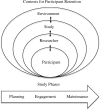Retaining participants in community-based health research: a case example on standardized planning and reporting
- PMID: 32393334
- PMCID: PMC7216482
- DOI: 10.1186/s13063-020-04328-9
Retaining participants in community-based health research: a case example on standardized planning and reporting
Abstract
Background: Effective strategies for participant retention are critical in health research to ensure validity, generalizability and efficient use of resources. Yet standardized guidelines for planning and reporting on retention efforts have been lacking. As with randomized controlled trial (RCT) and systematic review (SR) protocols, retention protocols are an opportunity to improve transparency and rigor. An RCT being conducted in British Columbia (BC), Canada provides a case example for developing a priori retention frameworks for use in protocol planning and reporting.
Methods: The BC Healthy Connections Project RCT is examining the effectiveness of a nurse home-visiting program in improving child and maternal outcomes compared with existing services. Participants (N = 739) were girls and young women preparing to parent for the first time and experiencing socioeconomic disadvantage. Quantitative data were collected upon trial entry during pregnancy and during five follow-up interviews until participants' children reached age 2 years. A framework was developed to guide retention of this study population throughout the RCT. We reviewed relevant literature and mapped essential retention activities across the study planning, recruitment and maintenance phases. Interview completion rates were tracked.
Results: Results from 3302 follow-up interviews (in-person/telephone) conducted over 4 years indicate high completion rates: 90% (n = 667) at 34 weeks gestation; and 91% (n = 676), 85% (n = 626), 80% (n = 594) and 83% (n = 613) at 2, 10, 18 and 24 months postpartum, respectively. Almost all participants (99%, n = 732) provided ongoing consent to access administrative health data. These results provide preliminary data on the success of the framework.
Conclusions: Our retention results are encouraging given that participants were experiencing considerable socioeconomic disadvantage. Standardized retention planning and reporting may therefore be feasible for health research in general, using the framework we have developed. Use of standardized retention protocols should be encouraged in research to promote consistency across diverse studies, as now happens with RCT and SR protocols. Beyond this, successful retention approaches may help inform health policy-makers and practitioners who also need to better reach, engage and retain underserved populations.
Trial registration: ClinicalTrials.gov, NCT01672060. Registered on 24 August 2012.
Keywords: Adolescents; Attrition; Pregnancy; Randomized controlled trial; Retention; Socioeconomic disadvantage.
Conflict of interest statement
The authors declare that they have no competing interests.
Figures
Similar articles
-
Improving children's health and development in British Columbia through nurse home visiting: a randomized controlled trial protocol.BMC Health Serv Res. 2016 Aug 4;16(a):349. doi: 10.1186/s12913-016-1594-0. BMC Health Serv Res. 2016. PMID: 27488474 Free PMC article. Clinical Trial.
-
The British Columbia Healthy Connections Project: findings on socioeconomic disadvantage in early pregnancy.BMC Public Health. 2019 Aug 22;19(1):1161. doi: 10.1186/s12889-019-7479-5. BMC Public Health. 2019. PMID: 31438906 Free PMC article.
-
Nurse home visiting and prenatal substance use in a socioeconomically disadvantaged population in British Columbia: analysis of prenatal secondary outcomes in an ongoing randomized controlled trial.CMAJ Open. 2020 Oct 27;8(4):E667-E675. doi: 10.9778/cmajo.20200063. Print 2020 Oct-Dec. CMAJ Open. 2020. PMID: 33109532 Free PMC article. Clinical Trial.
-
Canadian Contraception Consensus (Part 1 of 4).J Obstet Gynaecol Can. 2015 Oct;37(10):936-42. doi: 10.1016/s1701-2163(16)30033-0. J Obstet Gynaecol Can. 2015. PMID: 26606712 English, French.
-
How do trial teams plan for retention during the design stage of the trial? A scoping review.Trials. 2023 Dec 4;24(1):784. doi: 10.1186/s13063-023-07775-2. Trials. 2023. PMID: 38049833 Free PMC article.
Cited by
-
"This Is Me" an Awareness-Raising and Anti-Stigma Program for Undergraduate Nursing Students: A Pre-Post Intervention Study.Nurs Rep. 2024 Oct 12;14(4):2956-2974. doi: 10.3390/nursrep14040216. Nurs Rep. 2024. PMID: 39449453 Free PMC article.
-
Evaluating the Effectiveness of the Housing First for Youth Intervention for Youth Experiencing Homelessness in Canada: Protocol for a Multisite, Mixed Methods Randomized Controlled Trial.JMIR Res Protoc. 2023 Sep 19;12:e46690. doi: 10.2196/46690. JMIR Res Protoc. 2023. PMID: 37725430 Free PMC article.
-
Recruitment and retention of adolescents for an ecological momentary assessment measurement burst mental health study: The MHIM engagement strategy.Health Expect. 2024 Jun;27(3):e14065. doi: 10.1111/hex.14065. Health Expect. 2024. PMID: 38711174 Free PMC article.
-
Health and incarceration research in Australia: a scoping review.Lancet Reg Health West Pac. 2025 Mar 18;56:101500. doi: 10.1016/j.lanwpc.2025.101500. eCollection 2025 Mar. Lancet Reg Health West Pac. 2025. PMID: 40171471 Free PMC article. Review.
-
Exercise Interventions for Women with Ovarian Cancer: A Realist Review.Healthcare (Basel). 2022 Apr 13;10(4):720. doi: 10.3390/healthcare10040720. Healthcare (Basel). 2022. PMID: 35455897 Free PMC article. Review.
References
-
- Magnusson D, Cairns RB. Developmental science: toward a unified framework. In: Cairns RB, Elder H, Costello EJ, editors. Developmental Science. New York; Cambridge University Press. 1996:7–30.
Publication types
MeSH terms
Associated data
Grants and funding
LinkOut - more resources
Full Text Sources
Medical
Research Materials



